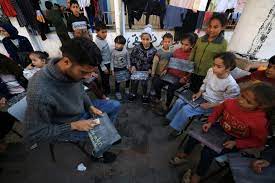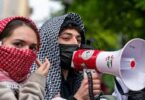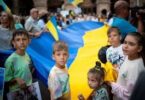RAFAH (Palestinian Territories) (AFP): Gaza teacher Tareq al-Ennabi arranges his pupils’ chairs in a circle, sets out the slates and chalk, and plans his lesson for the day: how to say in English “I love Palestine”.
Nearly two months ago, Hamas fighters streamed into Israel from the Gaza Strip in the worst attack in the country’s history, taking some 240 hostages and killing 1,200 people, most of them civilians, according to Israeli officials.
By the next day — a Sunday, and the first day of the week in Gaza — many of the territory’s schools had either become shelters for Palestinians displaced by Israel’s retaliatory bombing campaign, or been deserted altogether by students and teachers alike.
English teacher Ennabi, 25, was forced to abandon his United Nations-run school in Gaza City, which at the peak of the fighting was besieged by Israeli tanks.
But after weeks of fighting and a punishing Israeli air and ground campaign that has killed more than 15,000 people, according to Gaza’s Hamas-run government, Ennabi is back at the chalkface, teaching displaced children in Rafah in the south of the Gaza Strip.
His classroom is in the courtyard of a local school repurposed as a makeshift camp.
The building’s actual classrooms are now home to families sleeping on mattresses under the desks. Others bed down in the corridors where they at least have some shelter from the biting cold at night.
Instead, Ennabi teaches his class of around 40 boys and girls of all ages outdoors, using slates and chalk funded by small donations gleaned from here and there.
Sporting a neatly-trimmed black beard, jeans and a grey sweater, the teacher monitors the efforts of his young pupils as they learn to write “I love Palestine” in both Arabic and English.
Layan, 10, wearing a grey coat decorated with pink butterflies, concentrates hard on her work, but stops for a moment to explain how the bombing of their home forced the family to leave Gaza City.
“Now we sleep in this school. Uncle Tareq teaches us English,” she says, adding cheerfully that when she is older she too would like to be an English teacher.
GIVING CHILDREN A VOICE
For Ennabi, teaching English at a time of war is itself an act of defiance.
First “we give children their smile back and let them return to their lessons”, he told AFP.
Then “we help them to speak English, so they can be heard in the world”, Ennabi said.
For now he teaches alone, 40 students in the morning and 40 others in the afternoon, but he hopes to rally other volunteers to his cause.
In the Gaza Strip — a small, overpopulated territory ravaged by poverty — 81.5 percent of people are poor and 46.6 percent are unemployed, according to the UN. Almost half of the population is under the age of 15.
But after repeated conflicts which have destroyed many schools, and 17 years of Israeli blockade — particularly in terms of construction materials — children are inevitably missing out on education.
Even in peacetime, the UN, which manages more than 180 schools there, has been forced to resort to complicated timetables.
In some places, the available time is split into three sections, each catering to different groups of children, to give as many as possible at least a few hours of learning a day.
According to the Hamas government, the current war has led to the partial destruction of 266 schools, while 67 have been rendered completely unusable.







